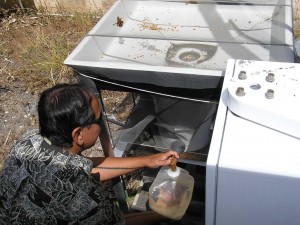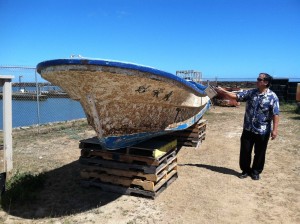IRHB Fukushima Disaster Response Site

EPA RadNet Air Monitoring
Overview:
On March 11, 2011, a 9.0-magnitude earthquake struck Japan and was followed by a 45-foot tsunami, resulting in extensive damage to the nuclear power reactors at the Fukushima Dai-ichi facility. Since that time, the Hawaii Department of Health (HDOH) has monitored the potential impact to our islands through the EPA’s RadNet system, as well as performing its own radiation surveillance on shorelines, Japan Tsunami Marine Debris (JTMD), and surface drinking water systems.
The results of past and present monitoring show that residents of Hawaii have not been exposed to levels of radiation from Fukushima that would be deemed a significant health risk, and that levels are far below any level of public health concern. This web page is intended to serve as a navigation hub to follow HDOH’s monitoring activities, as well as those of other federal, local and private entities.
Radiation Testing and Monitoring:
The Hawaii Department of Health (HDOH) has been monitoring the situation in the Pacific Ocean, and confers with the U.S. Food and Drug Administration (FDA) and other state radiation programs regarding radiation safety in food and seafood products. To date, FDA has no evidence that radionuclides from the Fukushima incident are present in the U.S. food supply at levels that would pose a public health concern. This is true for both FDA-regulated food products imported from Japan and U.S. domestic food products, including seafood caught off the coast of the United States. Consequently, FDA is not advising consumers to alter their consumption of specific foods imported from Japan or domestically produced foods, including seafood.
The HDOH continues to monitor the results of surveys and monitoring performed by TEPCO, as well as review scientific publications and reports from both private and public scientific institutions, to keep abreast of any potential impact on the ocean and sea life. HDOH also continues to perform shoreline surveillance on Oahu, Kauai, Maui and the Big Island utilizing radiation detection equipment to measure levels on the sand, rocks, and any marine debris that may have washed ashore. Results of the surveys performed since May 2011 remain consistent with normal background levels. Normal background radiation levels near the shoreline range from 1 to 5 microRoentgens per hour.
Air, precipitation, and drinking water samples continue to be collected following routine sampling protocols (EPA RadNet System). One air monitoring station in Honolulu continues to measure radiation levels throughout the state, and samples are collected twice a week. Drinking water samples are collected on a quarterly basis and precipitation samples are collected as rain capture permits. Samples are sent to the EPA laboratory in Alabama for analysis.

Shoreline Surveillance
*LATEST UPDATE – Oct. 20, 2017*
For some time after the Fukushima nuclear reactors were damaged, we posted readings of radiation levels around the state. There were elevated levels briefly, though they remained well below levels approaching a health risk. We have long since gone back to normal radiation levels found in Hawaii and will therefore discontinue posting readings and updates. Updates will be posted again if we receive information that there has been a release of some kind from Fukushima or elsewhere in the world. We continue to monitor air, drinking water, and precipitation through EPA’s RadNet system, and will maintain periodic shoreline surveillance activities.
Previous DOH Updates can be found here: HDOH Updates
Radiation Monitoring Data for Hawaii and West Coast States:
Air, drinking water and rainwater samples are sent to and analyzed by the U.S. Environmental Protection Agency (EPA). The results are posted on EPA’s RadNet website. EPA tests what is collected to look for any radioactivity that would represent a public health risk. You can do a search of sample results on EPA’s website here: EPA RadNet Monitoring Search Link
Hawaii Air Monitoring (EPA RadNet) – 2009 to 2010
Hawaii Air Monitoring (EPA RadNet) – 2011 to 2012
Hawaii Air Monitoring (EPA RadNet) – 2013
Hawaii Air Monitoring (EPA RadNet) – 2014
Hawaii Air Monitoring (EPA RadNet) – 2015
Hawaii Air Monitoring (EPA RadNet) – 2016
Hawaii Air Monitoring – EPA Search Link
Hawaii Air Monitoring – Current EPA RadNet Gamma Gross Count Data
Hawaii Drinking Water (HDOH) – Open Reservoirs (Outer Islands) April 2011
Hawaii Drinking Water (HDOH) – Open Reservoirs (Outer Islands) July 2011
Hawaii Drinking Water (HDOH) – Open Reservoirs (Outer Islands) October 2011
Hawaii Drinking Water (EPA RadNet) – 2009 to 2010
Hawaii Drinking Water (EPA RadNet) – 2011 to 2012
Hawaii Drinking Water (EPA RadNet) – 2013 to 2014
Hawaii Drinking Water (EPA RadNet) – 2013 to 2016
Hawaii Drinking Water Monitoring – EPA Search Link
Japan Tsunami Marine Debris (JTMD)/Shoreline Big Island – 2011 to 2012
JTMD/Shoreline Big Island – 2013 to 2014
JTMD/Shoreline Kauai – 2011 to 2012
JTMD/Shoreline Kauai – 2013 to 2014
JTMD/Shoreline Maui – 2011 to 2012
JTMD/Shoreline Maui – 2013 to 2014
JTMD/Shoreline All Islands – 2015
JTMD/Shoreline All Islands – 2016
Hawaii Milk Sampling (EPA RadNet) – 2009 to 2010
Hawaii Milk Sampling (EPA RadNet) – 2011 to 2012
Hawaii Milk Sampling (EPA RadNet) – 2013 to 2014
Hawaii Precipitation (EPA RadNet) – 2011 to 2012
Hawaii Precipitation (EPA RadNet) – 2013 to 2014
Hawaii Precipitation (EPA RadNet) – 2015 to 2016
Hawaii Precipitation Monitoring – EPA Search Link
Other State Agencies:
Alaska Division of Environmental Health – 2012-17 Testing Results
California Dept. of Public Health – Environmental Radiation Monitoring
Oregon Health Authority – Air Monitoring, Sand Monitoring, Water Monitoring, Japan Tsunami Marine Debris
Washington Dept. of Health – Air and Rainwater Monitoring, Fish and Shellfish Testing, Seawater Testing, Tsunami Debris Testing
Other Private Entities:
Pacific Islands Ocean Observing System (PacIOOS) – Radionuclide levels around the Hawai‘i Islands
Surfrider Foundation (Kauai Chapter) – Fukushima Radiation Monitored
Additional Resource Information (Last Updated 10/27/16):
United States Environmental Protection Agency (EPA) –
Japanese Nuclear Emergency: EPA’s Radiation Monitoring
RadNet Monitoring System
United States Food and Drug Administration (FDA) –
FDA Response to the Fukushima Dai-ichi Nuclear Power Facility Incident
Questions about Food Safety
State of Alaska (Division of Environmental Health) –
Fukushima Radiation Concerns in Alaska
State of California (Radiological Health Branch) –
Fukushima (Japan) Radiation Information
State of Oregon (Oregon Health Authority) –
State of Washington (Department of Health) –
Fukushima and Radioactivity in Washington
United Nations Scientific Committee on The Effects of Atomic Radiation (UNSCEAR) –
Health Physics Society (HPS) –
National Academy of Sciences (NAS) –
Woods Hole Oceanographic Institution (WHOI) –
FAQ: Radiation from Fukushima
Fukushima Radioactivity Detected Off West Coast (11/10/14)
Back to Radiation Section – Home Page
Last update: April 8, 2020


